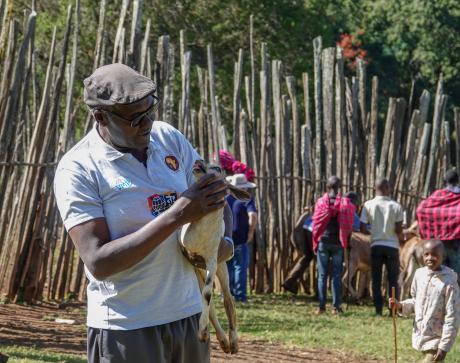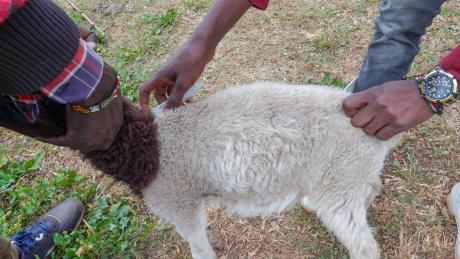Over 18,000 animals were treated after a MAF plane landed in a remote airstrip in the southern part of Kenya near the Kenya/Tanzania border.
The recent visit of the MAF plane to Enairebuk brought critical veterinary care to the local community and their animals, ensuring their well-being amidst the wild challenges they face.
For Kennedy and his fellow residents, the arrival of the MAF plane has consistently been a source of hope and blessing.
“I am grateful for MAF’s visit to our community, which brought not only veterinary doctors to tend to our animals free of charge but also spiritual support and the word of God,” said Kennedy.
MAF pilot Daniel Loewen-Rudgers flew a team of 20 veterinary doctors from the Veterinarians with a Mission Programme (VMP) to the remote region of Loita Hills among the Maasai community of Olorte within 30 minutes on air beating eight hours of road travel. Seven of the veterinary doctors were from the United States of America.
I am grateful for MAF’s visit to our community, which brought not only veterinary doctors to tend to our animals free of charge but also spiritual support and the word of God.
The success of the four-day veterinary camp was demonstrated by the 18,982 treated animals and a broader impact beyond just animal care. Over 300 men from the community received spiritual support and heard the word of God each morning before tending to their animals. A number of them committed themselves to follow Jesus Christ as their saviour.
Mr Philip Koyeti, a resident of Enairebuk and a staff at the RedTribe Organisation expressed his unwavering gratitude to MAF for bringing in the veterinary doctors to offer free services to the community.
“I am grateful to MAF for aiding our call and seeing the need to bring us, veterinary doctors to treat our animals, I don’t see any other way, this camp would have been successful,” said Koyeti.
Access to veterinary services by this community is difficult due to the remote location and geographical barriers of their land, but the timely arrival of the MAF plane with the veterinary doctors made a substantial impact on the health and well-being of the local livestock.
We received support from MAF who played a major role in providing air transport that ensured our timely arrival at Enairebuk.
Dr Mandieka, the founding member of Veterinarians with a Mission Programme (VMP) and leader for the Enairebuk mission, praised all the well-wishers and partners who contributed to the success of the mission, praising MAF for offering speedy transport to the team.
“We received support from MAF who played a major role in providing air transport that ensured our timely arrival at Enairebuk which without would have been difficult to reach by road,” he noted.
Enairebuk, nestled within the pristine Loita Hills forest, is not only a home to the Maasai community but also a habitat for majestic wild animals like the Leopard. However, the coexistence of humans and wildlife brings its share of challenges, as many animals often fall prey to their wild counterparts.

Unique clinical treatment:
A cow (bovine) bitten by Hyena
Dr Rick Miller (USA) and Dr Mwaura Brian (Kenya) encountered a bovine with a perianal region that had fallen victim to a hyena’s attack. The severity of the injury had caused a condition known as Myiasis where necrotic (dead) tissue and maggots had invaded the affected area.
The two skilled vets started by debriding the necrotic tissues and maggots ridding the wound of all the infected areas and then cleaning it thoroughly using hydrogen peroxide and water to disinfect it.
Dr Rick administered two sets of antibiotics to aid its healing and an anti-inflammatory to ease the pain and reduce the swelling.
The Maasai herder was then advised on ways to foster a clean environment conducive to the healing process of his cow.
Goat with Caprine Arthritis
A Maasai herder approached Dr Mwaura Brian and Dr Wanyama Philip with his goat that exhibited severe lameness and swelling in its leg joints, a clear indication of a health condition.
The two skilled professionals examined the goat’s gait, and joints and diagnosed it with Caprine Arthritis, a condition that threatened the goat’s mobility and overall health.
They commenced treatment by injecting the goat with pain relief and anti-inflammatory medicine to reduce the swelling and discomfort which would allow the goat to walk with ease.
The doctors recommended a clean and comfortable place be set aside for the ailing goat to allow ample rest and refrain strain of the affected joints.
Legishon, (not the actual name*) the owner of the goat, was grateful to the doctors for treating his goat.
“Had the doctors not shown up on time, my goat would have lost its ability to walk,” said Legishon, showing a sign of relief.
